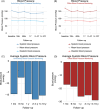Catheter-Based Renal Denervation for Resistant Arterial Hypertension: 10-Year Real-World Follow-Up Data
- PMID: 39565644
- PMCID: PMC11654853
- DOI: 10.1111/jch.14931
Catheter-Based Renal Denervation for Resistant Arterial Hypertension: 10-Year Real-World Follow-Up Data
Abstract
This analysis of real-world data examines the efficacy, safety, and long-term outcomes of renal denervation in hypertensive patients for up to 10 years. Sixty-five consecutive patients underwent renal denervation (RDN) (single operator) for uncontrolled resistant hypertension. Efficacy was defined as the interindividual change of office (OBPM) and ambulatory blood pressure monitoring (ABPM) at 1, 6, 12 months, 2-4 and 5-10 years after RDN. Medication changes, renal function, and device generation disparities were analyzed. Of these patients, 42 received RDN with a first-generation device, while 23 underwent the procedure with a second-generation device. Baseline demographics included a predominantly male cohort (57.6%) with an average age of 60.3 years. The mean number of medications at baseline was 4.3. OBPM at baseline was 169.0/87.4 mmHg, and ABPM at baseline was 153.4/88.4 mmHg. Post-procedure, significant reductions in systolic blood pressure (SBP) were observed in both OBPM and ABPM at 1 month (OBPM 147.9/82.8 mmHg; ABPM 141.3/83.0 mmHg [SBP, p < 0.001]), sustained up to 10 years (OBPM 153.1/84.3 mmHg; ABPM 138/80.1 mmHg [SBP, p < 0.001]). After 1 year around half of patients had a controlled OBPM and 24 h ABPM < 135/85 mmHg, which was associated with a higher number of ablation spots (31.5±14.8 vs. 15.5 ± 6.5, p = 0.002) and occurred more often when treated with a second-generation device (2 [12.5%] vs. 7 [77.8%], p = 0.002). Renal function displayed a minor physiological decline over 5-10 years. No major complication occurred. Renal denervation demonstrated sustained significant reductions in systolic OBPM and ABPM up to 10 years post-procedure. Controlled blood pressure at 1 year was associated with a higher number of mean ablated spots and the use of a second-generation device. The procedure exhibited a favorable safety profile, indicating its viability in managing hypertension without significant renal function compromise.
Keywords: arterial hypertension; device‐based treatment; renal denervation; treatment.
© 2024 The Author(s). The Journal of Clinical Hypertension published by Wiley Periodicals LLC.
Conflict of interest statement
The authors declare no conflicts of interest.
Figures


References
-
- Brouwers S., Sudano I., Kokubo Y., and Sulaica E. M., “Arterial Hypertension,” Lancet 398 (2021): 249–261. - PubMed
-
- Mancia G., Kreutz R., Brunstr M., et al., “2023 ESH Guidelines for the Management of Arterial Hypertension The Task Force for the Management of Arterial Hypertension of the European Society of Hypertension: Endorsed by the International Society of Hypertension (ISH) and the European Renal Association (ERA),” Journal of Hypertension 41 (2023): 1874–2071. - PubMed
-
- Barbato E., Azizi M., Schmieder R. E., et al., “Renal Denervation in the Management of Hypertension in Adults. A Clinical Consensus Statement of the ESC Council on Hypertension and the European Association of Percutaneous Cardiovascular Interventions (EAPCI),” European Heart Journal 17, no. 44 (2023): 1313–1330. - PubMed
MeSH terms
Substances
LinkOut - more resources
Full Text Sources
Medical

